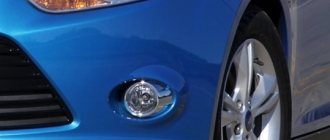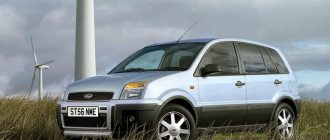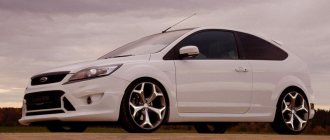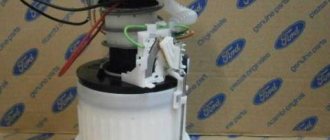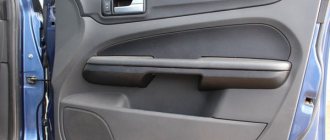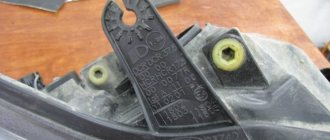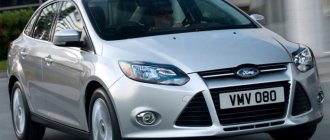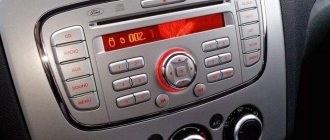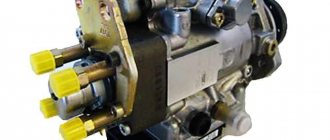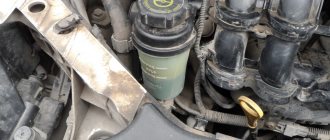The third generation Ford Focus is extremely popular both in our country and throughout the world. This is not surprising, because a low price combined with excellent quality is a formula for success. However, despite this, the Ford Focus 3 was originally designed for good roads, without a large number of potholes and other irregularities, which cannot be said about our roads. The problem is especially felt when driving in the outback, or on a dirt road when trying to go on a picnic. It is under such conditions that the front bumper quite often gets damaged, because the Ford Focus' ground clearance is relatively small. It is also common for the bumper to break when trying to park at the curb unsuccessfully, so you need to drive carefully and not drive too close.
Okay, if the bumper is damaged, what should you do in this case? If the crack is small, on a Ford Focus 3 it can be soldered or stapled together. In cases where this is impossible, there is only one way out - replacement. You can determine further actions either on your own or by seeking help from specialists. Regardless of their verdict, the part will have to be removed. However, there is no need to rush to give them money for the work, because you can do it yourself. For example, remove it yourself and take it for repairs, or install a new one. In order to cope with this operation on a Ford Focus 3, you need to know the design features and technology for removing the bumper, which will be discussed later in our article.
Flushing the injector on a Ford Focus 2
Removing the front bumper Ford Focus 3
The procedure for replacing and removing the front bumper of a Ford Focus 3 car is quite simple and can be performed by any car owner without any special skills in this type of repair.
Before you begin removing the front bumper, you will need to remove the headlights, otherwise you will not have access to the mounts. After removing the headlights, you can begin to unscrew the bolts in the wheel arch that secure the bumper.
The next stage of work will be to disconnect the hood opening rod, access to the fastenings of which became possible only after removing the headlights. Now there is nothing preventing you from removing the bumper, but do not forget that you will also need to disconnect the plug from the fog lights; it is also recommended to remove the bumper starting from the edges. The installation process is performed in the reverse order of the removal process.
Discuss
Select it and press Ctrl + Enter
In the new version, the Volkswagen Arteon will become a station wagon that will be sold on the Chinese market.
There is no official information about this, but the body for an unknown vehicle of this brand is already being assembled in China, and a year earlier, representatives of the German company announced the release of a station wagon.
The index, VW483/1, also indicates that the car has been put into production. The original model has VW483.
Later, information appeared that the car could be sold not only in China, but also in some European countries. There is no confirmation of this.
From the photographs that were taken at the Volkswagen plant, it becomes clear that the car’s ground clearance has increased, roof rails are now installed, and the sills have been supplemented with plastic overlays.
In the minimum configuration, the vehicle will receive a two-liter engine, the maximum power of which is 186 horsepower. It will be paired with a DSG gearbox.
Some car enthusiasts are expecting the appearance of a new V6 engine, which was previously announced by brand representatives.
The BMW Group has achieved record sales results for nine times in a row
In total, over the past year the German company managed to sell more than 2.5 million vehicles. The 2020 figure was 1.2% lower, although at that time it was considered a record.
The figure was most affected by sales of cars under the BMW brand. During the year, about 2.16 million vehicles were sold, which increased the result by 2%.
Rolls-Royce cars were also sold more. The brand's car dealerships found more than 5 thousand owners for new cars, which is 25% higher than the result of 2020.
Only sales of the MINI brand fell - by 4% to 346 thousand cars sold over the year.
The concern also increased sales of electric cars, which in 2020 were sold in the amount of 145 thousand units. This increased the figure by 2.2%.
The company believes that 2020 could be a record year, as total vehicle sales worldwide will increase. Whether the expectations of the concern's analysts will be met will become clear only at the end of this year.
Domestic motorists decided to conduct an unusual experiment, comparing two SUVs, the UAZ Patriot and the Suzuki Jimny.
The main difference between the cars from each other is the size. Under the hood of each is a standard power unit that is not particularly reliable. At the same time, the motors are simple and easy to maintain.
The interior of each SUV is quite spacious, despite the fact that the dimensions of the Suzuki Jimny, in comparison with the UAZ Patriot, are indeed very small. The luggage compartment of the Russian SUV is clearly superior to its Japanese rival.
Manufacturers of each concern are trying to do everything possible to modernize the presented SUVs, complementing them with new functions, including driver assistance functions and a collision avoidance system. The advantage of the new Patriot is its advanced multimedia system, which is superior to its Japanese counterpart.
The developers of Suzuki and UAZ do not indicate the acceleration time to 100 kilometers per hour, assuring that much depends on the road surface, driving style, and so on. Let us remind you that under the hood of the Japanese SUV there is a motor with a power of 149 horsepower. The Russian SUV is equipped with a 102-horsepower unit.
In the first case, buyers are offered a manual or automatic transmission. In the case of domestic SUVs, manufacturers mainly offer manual transmission. “Automatic” is provided only on updated models, the cost of which is significantly higher than their predecessors.
Removing the front bumper Ford Focus 3
However, the driver and passengers have less free space than in the previous generation of the model. This is one of the most significant disadvantages of the third generation Ford Focus. Although the seats themselves are quite comfortable, moderately soft. Landing on a long journey is not tiring.
The Ford Focus 3 is great, how to disassemble the front bumper of a Ford Focus 3. Even at high speeds, those in the cabin can talk in a whisper.
The noise from the engine is almost inaudible. The power units are quite reliable and unpretentious. This can be confirmed by the fact that the Ford Focus is extremely popular among professional taxi drivers. Gearboxes also do not give owners any trouble. The suspension adequately copes with road surface defects, making trips enjoyable. It is moderately soft, which allows you to maintain the necessary balance between comfort and controllability.
Removing the rear bumper on a Ford Focus II with your own hands
Was the rear of your car damaged due to a collision? Don’t rush to go to a car service center - just read the instructions on how to remove the rear bumper of a Ford Focus 2. This way you can quickly replace this body part, while saving a lot.
The dismantling process consists of the following step-by-step actions:
- First you need to remove the rear mudguards and fender liners on the right and left sides.
- Next, using a screwdriver, disconnect the power supply for the lights from the rear right.
- Using a screwdriver, disconnect the holder from the spar, then unscrew and pull out the pistons.
- Now you need to unscrew the screws located inside the wheel arches, and then open the rear door and also unscrew the fastening screws.
- By pulling the end holders, you can remove the rear bumper of your car.
This, in fact, is where the dismantling ends. In order to remove the rear bumper of a Ford Focus, you will need nothing more than a set of necessary tools, a few hours of free time and an assistant (which is optional). Further, all necessary operations to repair or replace this body part can be carried out.
Driving a car without bumpers is unacceptable, since this body part, in addition to its decorative function, ensures the safety of both the car itself and the driver and passengers in it.
The procedure for removing the front bumper on a Ford Focus 3
After removing one corner book, you need to move to the other side. The sequence of steps in this case is as follows: Remove the front wheels and install safety stands under the sills. Unscrew the T25 or T30 Torx screws and remove the mudguard. Remove the dirt protection panel.
Removing the front bumper Ford Focus 3
One side of the shield is placed behind the flange on the bumper, and the other is fixed to the radiator mounting frame with seven Torx screws.
Remove the fender liner mounted on Torx screws. Unscrew 2.
Remove the headlight, how to disassemble the front bumper Ford Focus 3 is held on by one screw and the wiring harness block. Similarly, remove the remaining pins securing the front bumper to the radiator mudguard. This is how the pistons attaching the front bumper to the radiator mudguard are located. Remove the two bolts securing the side bumper to the front fender. Use a screwdriver to pry the piston securing the bumper side fastening clamp to the front fender.
Remove the piston. Remove the bumper side mounting clip. However, it is not difficult to complete the bumper removal task yourself while saving money at the same time.
Take out the part, you can repair it and you can buy a new one.
If you want to install a front or rear bumper, it is quite possible to do it yourself. Before starting work, it is very advisable to become familiar with the technology. That's pretty. Ford Focus 3 bumper How to remove the front bumper? The third generation Ford Focus front bumper is composite. This is a decorative cover & Most often with light impacts, only the lining suffers.
It can be replaced separately from the amplifier. In more serious cases, the amplifier itself is changed. Before starting work, it is very advisable to stock up on holders, as they break quite easily. How to disassemble the front bumper of a Ford Focus 3; the presence of an assistant will greatly simplify the task.
First of all, the headlights are removed from the car. The third generation Ford Focus does this very well. Tighten the two headlight mounting bolts. The headlight is then carefully lifted and pulled towards. After this, a connector with wires will be accessible, which must be disconnected.
This is usually done by tapping with a screwdriver. The same is done with the second headlight.
Replacing the clutch in a Ford Focus 1 Ford Focus 1video We will learn how to change the clutch on a 1 with your own hands. Changing the clutch is one of the most common types of car repairs. On average, the service life of domestic production does not exceed thousands of kilometers, and imported ones - 1.5 times.
Ford Focus 2 Removing the rear bumper remove replacement repair Ford Focus 2
Ford Focus 2 > Car repair > Body > Removing the rear bumper
We carry out work in the repair and replacement of the rear bumper and its amplifier. The work should be done with an assistant. From the bottom of the car, we disconnect the wiring harness blocks of the fog lights (see “Replacing the lamp in the rear fog light and reversing light in a Ford Focus 2 hatchback”).
Using a Phillips screwdriver, unscrew the lower self-tapping screw securing the left mudguard.
Using a Torx T-25 wrench, unscrew the self-tapping screw securing the upper mudguard holder...
...and remove the holder.
Unscrew the remaining two mudguard holders...
...and remove it.
Mounting points for the left mudguard.
Similarly, remove the right mudguard.
On the left and right sides of the car, use a 10mm socket to unscrew the nuts for the side fastening of the bumper.
Using a 10" socket, unscrew the rear bumper mounting screws on both sides of the car.
From the bottom of the car, use a Phillips screwdriver to unscrew the fasteners of the two pistons securing the bumper to the plastic cushions.
We take out the pistons.
Applying the necessary force, we separate the sides of the bumper from the body, overcoming the resistance of the clamps, one on each side.
Location of the lock on the side of the bumper.
Remove the rear bumper.
On each side of the car, using a 13mm socket, unscrew three nuts securing the flanges of the bumper amplifier to the body...
...and remove it.
We install the amplifier and rear bumper of Ford Focus 2 in the reverse order.
Removing the rear bumper Ford Focus 2
Primary source of content - WiKi of the Za Rulem magazine website
ford-focus-2.dv13.ru
Features of the third generation Ford Focus
Ford Focus has long gained popularity among Russian buyers. The first generation of the car was in great demand. The second one became a bestseller. We can say that the third generation of Ford Focus cars has become popular.
While maintaining high reliability and excellent driving quality, the new Ford Focus has acquired its own merits. However, the shortcomings did not pass him by. The car is available in three body styles:
The third Ford Focus is slightly longer and wider than its predecessor, although it is not noticeable from the outside. More noticeable is that it is slightly lower. This contributed to improved aerodynamic characteristics. The salon has also changed, becoming more modern and youthful. However, the driver and passengers receive less free space than in the previous generation of the model. This is one of the most important shortcomings of the third generation . Although the seats themselves are quite comfortable, moderately soft. Landing on a long road is not tiring.
Ford Focus 3 has excellent sound insulation. Even at high speeds, those inside the cabin can speak in whispers. The noise from the engine is almost inaudible. Power supplies are quite reliable and unpretentious. This can be confirmed by the fact that the Ford Focus is extremely popular among professional taxi drivers. Transmissions also do not cause problems for owners.
The pendant adequately copes with road surface defects, making trips enjoyable. It is moderately soft, which allows you to maintain the necessary balance between comfort and handling. However, severe roughness of the roadway must nevertheless be handled very carefully. And not only save the suspension.
Among the disadvantages of the model, in addition to the rather tight cabin, you can identify the low ground clearance. European versions have a resolution of 140 millimeters. According to the manufacturer, on cars for the Russian market, ground clearance has been increased to 165 millimeters. However, not all owners agree with this. Even small holes and ruts must be traveled very carefully so as not to catch the bottom of the road or damage the front or rear bumper. On the road and in the city where they forgot about road repairs, by the way, there is a very high risk of the threshold being crushed. Well, the bumper is very close to the ground and is often the first to suffer.
Ford Focus 3, bumper repair.
The car was clearly created for good, smooth roads. However, in Russia they are far from everywhere. Therefore, a trip into the interior of the country may cause unpleasant surprises. A picnic trip can be ruined. It's easy to damage the bumper
in the city. To do this, it is completely inconvenient to park next to the sidewalk. It is usually higher than the bottom edge of the front bumper, making it very dangerous to approach curbs.
What to do if the bumper is damaged? If the defect is small and the part does not crack, then repair will be quite feasible. If the crack is serious, it will require replacement. The specialist will determine the need for one or another option. However, it is not difficult to complete the bumper removal task yourself while saving money at the same time. Take out the part, you can repair it and you can buy a new one. If you want to install a front or rear bumper, it is quite possible to do it yourself. Before starting work, it is very advisable to become familiar with the technology. It's pretty simple.
Ford Focus 3 bumper
How to remove the front bumper?
The third generation Ford Focus front bumper is composite. This is a decorative cover & Most often with light impacts, only the lining suffers. It can be replaced separately from the amplifier. In more serious cases, the amplifier itself is changed.
Before starting work, it is very advisable to stock up on holders, as they break quite easily. In addition, the presence of an assistant will greatly simplify the task. First of all, the headlights are removed from the car. In the third generation Ford Focus this is done very simply. Tighten the two headlight mounting bolts. Then the headlight carefully rises and pulls towards itself. After this, a connector with wires will be available, which must be disconnected. This is usually done by tapping with a screwdriver. The same is done with the second headlight.
Design features, its functions
To remove the front bumper of a Ford Focus 3, you will need two sockets (10 and 13 mm), a flat-head screwdriver and a Torx T30 socket. The procedure for dismantling parts is the same for machines of any configuration and is carried out as follows:
- Remove the fender liners and engine protection.
- Disconnect the radiator splash guard mounted on six pistons.
- Unscrew the bolts securing the wing and remove the remaining pistons (one per side).
- Unscrew the nuts on the side mounting of the bumper.
- Remove the plastic fastener.
- Remove the four screws securing the radiator splash guard to the mounting frame.
- Remove the mudguard from its seat.
- Put your hands through the resulting holes and disconnect the plugs of the fog lights.
- Remove both headlights from the vehicle.
- Disconnect the hood lock drive cable from the opening handle.
- Remove the pins and mounting screws on the top.
- Dismantling is complete.
Ford Focus 2 Manual
We carry out work when repairing and replacing the front bumper.
We carry out the work on an inspection ditch or overpass. On a Ford Focus 2 with a hatchback body, we disconnect the wire blocks from the fog lights (see “Replacing the fog light bulb, removing the Ford Focus 2 fog light”).
Remove the mudguard of the radiator of the cooling system (see “Removing the radiator shield of Ford Focus 2”).
Using a Torx T-30 wrench, unscrew the lower...
...and the upper screws securing the right fender liner to the bumper.
Similarly, unscrew the screws securing the left fender liner to the bumper.
Using a Phillips screwdriver, unscrew the two screws for the upper bumper mounting to the upper cross member of the engine compartment.
From the bottom of the car, using a 10mm head, unscrew the two self-tapping screws securing the bumper to the right fender.
Similarly, unscrew the two bolts of the left fastening of the bumper to the fender.
We move the sides of the bumper away from the right and left wings, overcoming the resistance of the clamps.
Position of the lock on the right wing (for clarity, the headlight has been removed)
By prying up the right holder of the upper cross member of the engine compartment, we remove the bumper fixing tab from it.
Similarly, remove the left bumper tab from the holder.
By pressing the three bumper latches located in the center of the car, we remove them from the grooves in the upper cross member of the engine compartment...
...and remove the front bumper.
We install the front bumper of Ford Focus 2 in the reverse order.
Removing the front bumper Ford Focus 2
Front bumper
Fastening the element is quite simple, and the part can be removed from the car with your own hands. The work is done by one person.
Step-by-step removal instructions
Before starting work, the vehicle must be placed on a horizontal base with a hard surface. Removing the front bumper on a Ford Focus 2 (restyling) should begin from the attachment points on either side of the car. After removing one corner, you need to move to the other side. The sequence of steps is as follows:
- Remove the front wheels and install safety stands under the sills.
- Unscrew the T25 or T30 Torx screws and remove the mudguard.
- Remove the dirt protection panel. One side of the shield is placed behind the flange on the bumper, and the other is fixed to the radiator mounting frame with seven Torx screws.
- Remove the fender liner mounted on Torx screws.
- Unscrew the 2 10 mm bolts securing the Focus 2 bumper to the front fender.
- Remove the headlight, which is held on by one screw and the wiring harness block.
- Unscrew the third 10 mm bolt under the headlight.
- Remove the 2 radiator grille mounting screws.
- Unfasten the latches on the bottom edge with a flat-head screwdriver and remove the grille.
- Follow the same steps to remove the fasteners on the other side.
- Carefully remove the bumper from the amplifier and disconnect the fog light connectors.
Installation
Installation of the repaired part is carried out in the reverse order. The order of work is as follows:
- Before installation, connect the fog lamp plugs.
- Place the bumper on the amplifier and center it.
- Tighten the fastening bolts on one side and the other, controlling the uniformity of the gap between the plastic part, the body and the headlights.
In order to remove this part on a third-generation Ford Focus, you will need a minimum set of tools, including a flat-head screwdriver, 10 and 13 keys, pliers, Torx-T30.
Before proceeding directly to removing the front bumper, it is advisable to purchase special holders that break very easily. Also, having an assistant will make the procedure much easier and faster.
content .. 197 198 199 200 ..Ford Focus 1. How to remove the front and rear bumpers
How to remove the front bumper
The procedure for different brands of cars may differ slightly, but in general the procedure is always approximately the same. To remove the front bumper, you will need a 10mm socket wrench and a Phillips screwdriver. In general, the work will not take more than half an hour of your time if you do everything correctly.
First you need to park the car on a flat, well-lit area. Then you should open the hood and carefully examine the protective plastic trims - they are located under the radiator. In order to gain full access, you need to remove the protective cover, the main function of which is to hide the clamps and screws that hold the fastening. All these dismantled parts are preserved so that the element can be put back in its original place.
Removal begins with the screws that are located in the middle, and then you should move to the side fasteners. The screws are loosened and removed using a pre-supplied screwdriver - this procedure will have to be done at least 12 times. In some older car models, the bumper is attached to the frame with four bolts - these should also be found and disconnected.
When the fastenings are removed, it is necessary to examine the place where the element being dismantled adjoins the wings of the car. The part needs to be disconnected from the wings, as well as from the headlights. The edges of the bumper are pulled out very carefully, since the high density of the structure makes it quite likely that there is a risk of damage to other parts.
Now, the last thing that holds the removable part to the body is the clamps. Finding the right clamps is quite simple - there should be four of them. To gently open them, you will need a second assistant to hold the piece on one side while you work on the other. The clamps themselves can have a hooked design, or be made in the form of latches. To dismantle it in the first case, it will be enough to simply lift it. The second option involves bending the clamps using a screwdriver.
Then you should disconnect the wires that are connected to the headlights in the bumper and the part can be removed. If it still does not want to come off, then you have missed some kind of clamp or fastening.
Attaching the front bumper to its original place occurs in the same way as removing it, only in the reverse order.
How to remove the rear bumper
If your car has a sedan body, you just need to remove the luggage compartment mat, but a station wagon requires complete removal of the rear door trim. In addition, the luggage compartment may contain side trim, which must be removed from the fixing parts and pulled slightly to the side.
Next, a socket wrench with a 5-6 cm extension is placed between the rear wing and the trim. It is put on bolts, which we carefully unscrew.
Afterwards you need to disconnect the fasteners that are located on both sides. These are self-tapping screws connecting the rear bumper to the fender liner. Finally, you can press firmly on the element so that it separates from the brackets on the body. Then it lifts up and is carefully removed from the back of the car.
This completes the process. Attaching the rear bumper to its original place occurs in the same way as removing it, only in the reverse order.
content .. 197 198 199 200 ..
Rear bumper
The plastic casing of the element on sedan cars is attached to two screws located under the lower edge of the trunk lid, two plastic clips on the lower edge of the bumper, two self-tapping screws under the decorative rubber trim and two nuts.
Removal
To dismantle the rear bumper on the Focus 2 hatchback, follow these steps:
- Remove the mudguards by unscrewing 4 screws (Phillips head and Torx type).
- Unscrew the screws under the trunk lid and remove the pistons on the bottom of the bumper.
- Disconnect the connecting block of the wiring harness for the rear fog lamp and the reverse gear warning light from the bracket.
- Disconnect the wiring plugs and remove the harness holder from the hole in the side member.
- Unscrew the nuts located inside the arch. In case of severe corrosion, they begin to turn the mounting bolt. In this case, it is recommended to cut them off with a hacksaw, drill out the remains and replace them.
- Pull the corners of the bumper at the wheel arches and remove it from the mounts. It is more convenient to completely dismantle a part from a car with two people.
- To remove the reverse lamps and fog lamps, turn the lamp holders counterclockwise. The wiring harness is fixed on eight special holders. If necessary, the wiring can be removed from them using a screwdriver.
- If damaged, the rear reinforcing beam is removed and replaced. It is attached to the side members with 6 13 mm nuts.
Removing a similar part from a Focus 2 with a station wagon body does not have any fundamental differences.
Removing, disassembling and installing the rear bumper
- Repair manuals
- Ford Focus 2 2005-2008
- Removing, disassembling and installing the rear bumper
You will need: all the tools necessary to remove the mudguards and wheel arch liners (see “Removing and installing wheel mudguards and wheel arch liners”), as well as a “10” socket head, “10”, “13” keys, screwdrivers with cross-shaped and flat blades.
1. On both sides of the car, remove the mud flaps and rear wheel fender liners (see “Removing and installing wheel mud flaps and fender liners”).
| 2. From the bottom of the car in its right rear part, disconnect the wiring harness block for the reversing light and rear fog light from the bracket by prying it off with a screwdriver. | 3. Squeezing the pad clamps... |
| 4. ...disconnect it. | 5. Use a screwdriver to pry off the holder of the wiring harness for the reversing light and rear fog light... |
| 6. ...disconnect the holder from the body side member. | 7. From the bottom of the bumper on both sides, unscrew the fasteners of the two pistons securing the bumper to the body... |
| 8. ...and, prying it with a screwdriver... | 9. ...remove the pistons. |
| 10. From inside both rear wheel arches, unscrew one nut securing the ends of the bumper to the body. | 11. Open the tailgate and on both sides of the car remove one screw for the upper bumper-to-body mounting. |
| 12. Pull outward to disconnect the bumper end holders from the body... | 13. ...and remove the rear bumper. |
| 14. If the rear bumper is removed for replacement, remove the reverse light, fog light and wiring harness from the rear bumper, and then install them on the new bumper. To do this, turn the reversing light and fog light bulb sockets counterclockwise... | 15. ...and remove the sockets along with the lamps from both lamps. |
16. Using a screwdriver, disconnect the eight wire harness holders from the bumper and remove the harness.
| Note This is how the wiring harness holders are located on the rear bumper. |
| 17. Press the latches... | 18. ...and remove the lights. |
19. If the rear bumper beam is damaged, unscrew the four nuts on both sides of the car securing the beam to the body side members (one of the nuts is not visible in the photo, as it is covered by the beam) and remove the beam.
20. Install the rear bumper and all removed parts in the reverse order of removal.
Download information from the page
↓ Comments ↓
Section 1. Vehicle design
General information about the car Passport data Car keys Controls Heating (air conditioning) and interior ventilation Doors Seat belts Seats Steering wheel adjustment Rear view mirrors Interior lighting Sun visors Interior storage compartments Hood Gearbox control Roof rack
Section 2. Recommendations for use
Safety rules and recommendations What you need to have in your car Running in the car Operating the car during the warranty period Preparing the car for departure Filling the car with gasoline Using a jack Towing the car
Section 3. Problems along the way
The engine does not start Malfunctions of the fuel injection system Idle has disappeared Interruptions in engine operation Diagnostics of the engine condition by the appearance of the spark plugs The vehicle moves jerkily The vehicle accelerates poorly The engine stalls while driving The oil pressure has dropped Engine overheating The battery does not recharge Starting the engine from external power sources Malfunctions of electrical equipment Extraneous knocking noises appear Problems with the brakes Puncture of a wheel
Section 4. Maintenance
General provisions Daily maintenance (EO) First maintenance (MOT-1) Second maintenance (MOT-2)
Section 5. Engine
Design features Possible engine malfunctions, their causes and solutions Useful tips Checking compression in the cylinders Removing and installing the engine mudguard Replacing the power unit suspension mounts Installing the piston of the first cylinder to the TDC position of the compression stroke Removing, installing and troubleshooting the flywheel Replacing engine seal parts Adjusting clearances in the drive valves Cylinder head Removal and installation of the engine Lubrication system Cooling system Exhaust system Engine power supply system Fuel vapor recovery system
Section 6. Transmission
Clutch Gearbox Front wheel drives
Section 7. Chassis
Front suspension Rear suspension
Section 8. Steering
Design features Possible malfunctions of power steering, their causes and solutions Steering column Steering rods Steering mechanism
Section 9. Brake system
Features of the device Possible malfunctions of the brake system, their causes and solutions Bleeding the hydraulic drive of the brake system Checking the position of the brake pedal Master brake cylinder Vacuum brake booster Replacing hoses and tubes of the hydraulic brake drive Removing and installing the brake pedal Brake mechanisms of the front wheels Brakes of the rear wheels Parking brake Anti-lock brake system
Section 10. Electrical equipment
Design features Diagnostics of malfunctions of on-board electrical equipment Mounting blocks Battery Generator Starter Ignition switch (lock) Engine control system Lighting, light and sound alarms Replacement of the windshield window wiper motor Replacement of the tailgate window wiper motor Removal and installation of the windshield washer Replacement of the front door window regulator motor Removal and installation of the electric motor of the radiator fan of the engine cooling system Replacement of the additional resistance of the radiator fan of the engine cooling system Removal and installation of the electric motor of the heater Replacing the additional resistance of the electric heater fan Electric heating of the glass of the rear window (tailgate) Instrument cluster Instrument panel switches Replacement of the control unit for electric windows and electric mirrors Car audio system Replacement of sensors and switches
Section 11. Body
Design features Possible body malfunctions, their causes and solutions Removal and installation of the radiator lining Removal and installation of wheel mudguards and wheel arch liners Removal and installation of bumpers Removal and installation of the front fender Removal and installation of the engine compartment frame and front bumper beam Removal and installation of the air intake and drainage box grille shield Hood Side doors Tailgate of hatchback cars Fuel tank filler hatch cover Seats Removal and installation of floor tunnel lining Passive safety system (SRS) Rear view mirrors Instrument panel Heater and air conditioner Interior fittings Removal and installation of interior linings Removal and installation of trunk linings Windshield wiper windshield Windshield wiper for tailgate window Replacing fixed glazing of the body Removing and installing the battery mounting shelf Caring for the body
Section 12. Wheels and tires
Technical characteristics Marking of rims Marking of tires Changing wheels Wheel nuts Breaking in tires Storing tires Balancing wheels Snow chains Spare wheel Checking tire pressure Checking tire tread Checking valves Checking radial and lateral runout of rims
Section 13. Purchase of spare parts
Engine oil Lubricants Coolants Brake fluid Fuel filter Air filter Engine oil filter Spark plugs
Section 14. A trip to the service station
Section 15. Winter operation of the vehicle
How to prepare a car for winter Recommendations for starting the engine in severe frost What is useful to buy for winter Useful winter tips
Section 16. Preparation for technical inspection
Recommendations List of malfunctions and conditions under which the operation of vehicles is prohibited Changes to state standards regulating the maximum permissible content of harmful substances in the exhaust gases of motor vehicles
Section 17. Tips for a novice auto mechanic
Safety precautions when carrying out repair work Tools Before starting work Restoring threaded connections Tips for body repair
Applications
Appendix 1. Tightening torques of threaded connections, Nm Appendix 2. Overall dimensions (mm) of Ford Focus II cars with sedan and station wagon bodies Appendix 3. Technical characteristics of engines and performance indicators of cars depending on the type of engine used Appendix 4. Air pressure in cold tires Appendix 5. Filling volumes, l
Electrical circuit diagrams
Diagram 1. Windshield wiper and washer connections Diagram 2. Battery charging system connections Diagram 3. Brake system hydraulic drive system connections Diagram 4. Ventilation, heating and air conditioning system connections Diagram 5. Engine starting system connections Diagram 6a. Speed control system connections Diagram 6b. Speed control system connections Diagram 7a. Engine control system connections Scheme 7b. Engine control system connections Scheme 7c. Engine control system connections Scheme 7d. Engine control system connections Scheme 7d. Engine control system connections Diagram 7e. Engine control system connections Scheme 7g. Engine control system connections Scheme 8a. Air conditioning system connections Diagram 8b. Air conditioning system connections Diagram 9. Power steering system connections Diagram 10a. Anti-lock brake system (ABS) connections Scheme 10b. Anti-lock brake system (ABS) connections Diagram 11. Vehicle Dynamic Stability System connections
